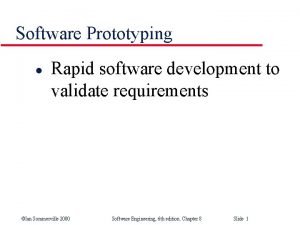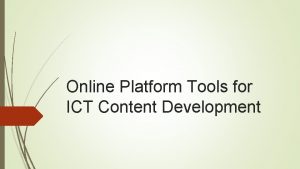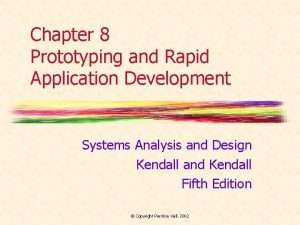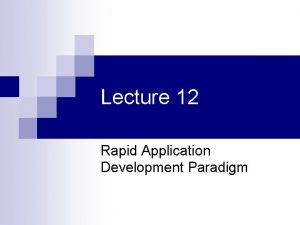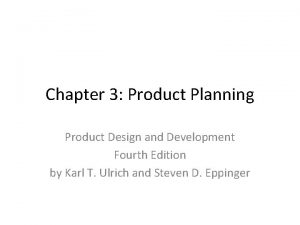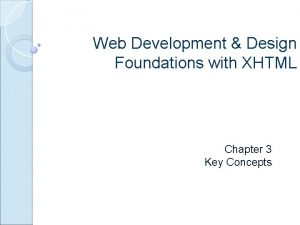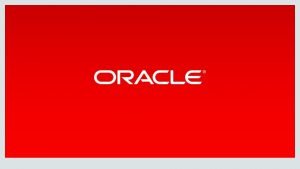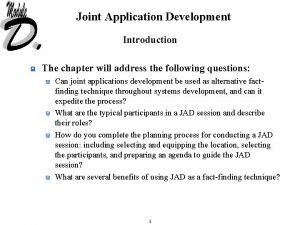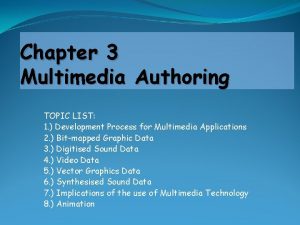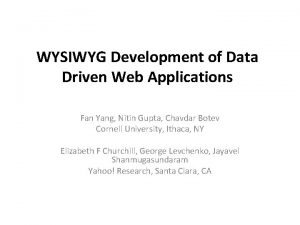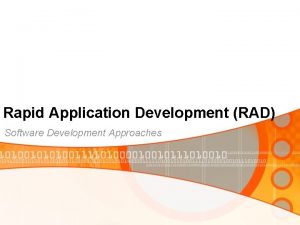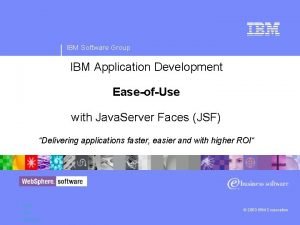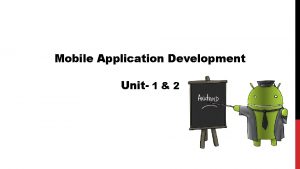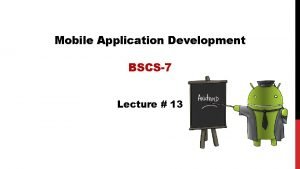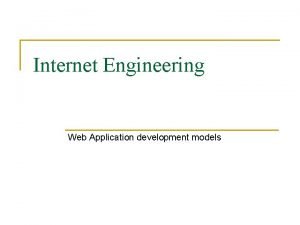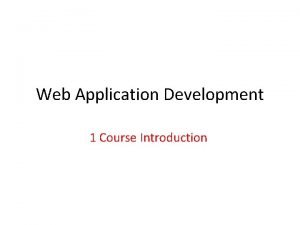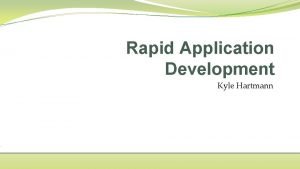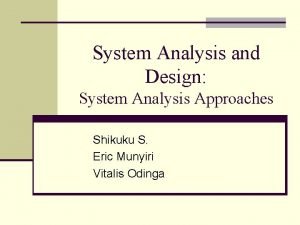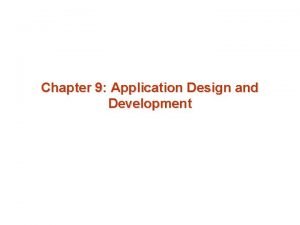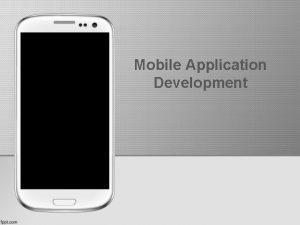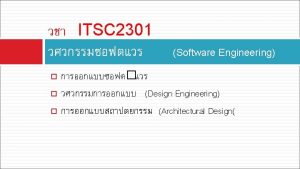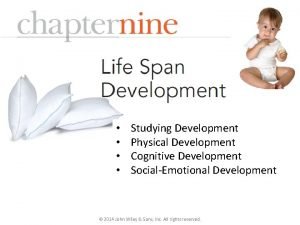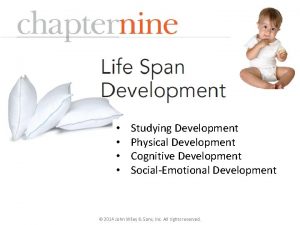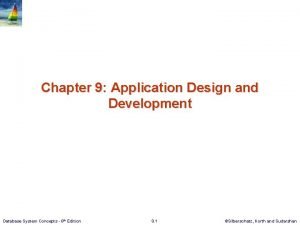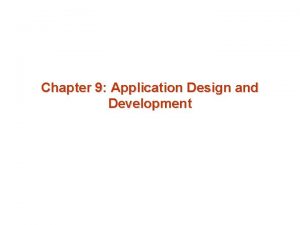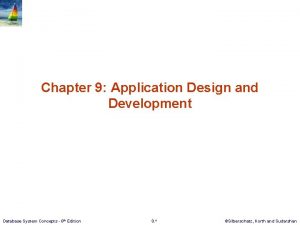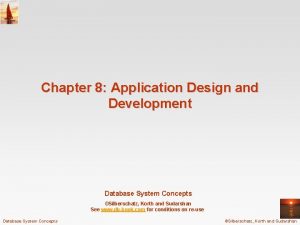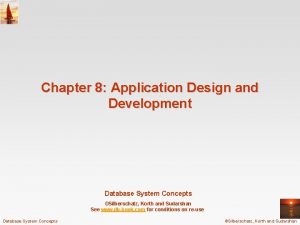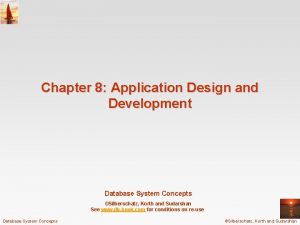Chapter 9 Application Design and Development n Application
































- Slides: 32

Chapter 9: Application Design and Development n Application Programs and User Interfaces n Web Fundamentals n Servlets and JSP n Rapid Application Development n Application Performance n Application Security Database System Concepts - 6 th Edition 9. 1

Application Programs and User Interfaces n Most database users do not use a query language like SQL n An application program acts as the intermediary between users and the database l Applications split into 4 front-end 4 middle layer: containing “business logic”, which execute specific requests, enforcing rules, etc. – Example: 選課不能衝堂, 領錢後帳戶餘額不能少於 1000元 4 backend: communicating with a database n Front-end: user interface l Forms l Graphical user interfaces l Many interfaces are Web-based Database System Concepts - 6 th Edition 9. 2

Application Architecture Evolution n Three distinct era’s of application architecture l mainframe (1960’s and 70’s) l personal computer era (1980’s) l We era (1990’s onwards) Database System Concepts - 6 th Edition 9. 3

Web Interface n Web browsers have become the de-facto standard user interface to databases l Enable large numbers of users to access databases from anywhere l Avoid the need for downloading/installing specialized code, while providing a good graphical user interface 4 l Javascript, Flash and other scripting languages run in browser, but are downloaded transparently Examples: banks, airline and rental car reservations, university course registration and grading, an so on. Database System Concepts - 6 th Edition 9. 4

The World Wide Web n The Web is a distributed information system based on hypertext. n In the Web, functionality of pointers is provided by Uniform Resource Locators (URLs). n URL example: http: //www. acm. org/sigmod l The first part indicates how the document is to be accessed 4 “http” indicates that the document is to be accessed using the Hyper Text Transfer Protocol. l The second part gives the unique name of a machine on the Internet. l The rest of the URL identifies the document within the machine. n The local identification can be: 4 The path name of a file on the machine, or 4 An identifier (path name) of a program, plus arguments to be passed to the program – E. g. , http: //www. google. com/search? q=silberschatz Database System Concepts - 6 th Edition 9. 5

HTML n Most Web documents are hypertext documents formatted via the Hyper. Text Markup Language (HTML). n HTML documents contain l formatting: text along with font specifications, and other instructions including tables, stylesheets (to alter default formatting), and image display features etc. l hypertext links to other documents, which can be associated with regions of the text. l forms, enabling users to enter data which can then be sent back to the Web server, to be acted upon by an executable at the server, 4 which can generate Web documents dynamically based on user information n Input features provided by HTML 4 Select from a set of options – Pop-up menus, radio buttons, check lists 4 Enter values – Text boxes Database System Concepts - 6 th Edition 9. 6

Sample HTML Source Text <html> <body> <table border> <th>ID</th> <th>Name</th> <th>Department</th> </tr> <td>00128</td> <td>Zhang</td> <td>Comp. Sci. </td> </tr> …. </table> <form action="Person. Query" method=get> Search for: <select name="persontype"> <option value="student" selected>Student </option> <option value="instructor"> Instructor </option> </select> Name: <input type=text size=20 name="name"> <input type=submit value="submit"> </form> </body> </html> Database System Concepts - 6 th Edition 9. 7

Display of Sample HTML Source Database System Concepts - 6 th Edition 9. 8

Web Servers n A Web server accepts requests from a Web browser and sends back results in the form of HTML documents. n The document name in a URL may identify an executable program, that, when run, generates a HTML document. l The Web client can pass extra arguments with the name of the document. n A Web server can act as an intermediary to provide access to a variety of information services. l To install a new service on the Web, one simply needs to create and install an executable that provides that service. l The Web browser provides a graphical user interface to the information service. n Common Gateway Interface (CGI): a standard defines how the Web server communicates with application programs. Database System Concepts - 6 th Edition 9. 9

Mostly-used Web Architecture n Application program runs within the Web server. Database System Concepts - 6 th Edition 9. 10

HTTP and Sessions n The HTTP protocol is connectionless l That is, once the server replies to a request, the server closes the connection with the client, and forgets all about the request 4 Motivation: reduces load on server 4 operating systems have tight limits on number of open connections on a machine l In contrast, Unix logins, and JDBC/ODBC connections stay connected until the client disconnects 4 retaining user authentication and other information n Information services need session information l E. g. , user authentication should be done only once per session n Solution: use a cookie Database System Concepts - 6 th Edition 9. 11

Sessions and Cookies n A cookie is a small piece of text containing identifying information l Sent by server to browser 4 Sent l Sent by browser to the server that created the cookie on further interactions 4 part l on first interaction, to identify session of the HTTP protocol Server saves information about cookies it issued, and can use it when serving a request 4 E. g. , authentication information, and user preferences n To track a user session, an application may generate a session identifier, and send a cookie containing the session identifier. n Cookies can be stored permanently or for a limited time. Database System Concepts - 6 th Edition 9. 12

※ Servlets n Java Servlet specification defines an API for communication between the Web/application server and application program running in the server l E. g. , methods to get parameter values from Web forms, and to send HTML text back to client n Application program (also called a servlet) is loaded into the server (see text for the sample code) n Servlets run inside application servers such as l Apache Tomcat, IBM Web. Sphere and Oracle Application Servers n Application servers support l deployment and monitoring of servlets l Java 2 Enterprise Edition (J 2 EE) platform supporting objects, parallel processing across multiple application servers, etc Database System Concepts - 6 th Edition 9. 13

※ Servlet Sessions n Servlet API supports handling of sessions l Sets a cookie on first interaction with browser, and uses it to identify session on further interactions n To check if session is already active: l if (request. get. Session(false) == true) 4. . then existing session 4 else l . . redirect to authentication page 4 check login/password 4 request. get. Session(true): creates new session n Store/retrieve attribute value pairs for a particular session l session. set. Attribute(“userid”, userid) l session. get. Attribute(“userid”) Database System Concepts - 6 th Edition 9. 14

Server-Side Scripting n Server-side scripting simplifies the task of connecting a database to the Web l Define an HTML document with embedded executable code/SQL queries. l Input values from HTML forms can be used directly in the embedded code/SQL queries. l When the document is requested, the Web server executes the embedded code/SQL queries to generate the actual HTML document. n Numerous server-side scripting languages l JSP, PHP, ASP (ASP. net) l General purpose scripting languages: VBScript, Perl, Python Database System Concepts - 6 th Edition 9. 15

Java Server Pages (JSP) n A JSP page with embedded Java code n Example: <html> <head> <title> Hello </title> </head> <body> <% if (request. get. Parameter(“name”) == null) { out. println(“Hello World”); } else { out. println(“Hello, ” + request. get. Parameter(“name”)); } %> </body> </html> n JSP scripts are translated into servlets that are then compiled. Database System Concepts - 6 th Edition 9. 16

PHP n PHP is widely used for Web server scripting n Extensive libaries including for database access using ODBC n Example: <html> <head> <title> Hello </title> </head> <body> <? php if (!isset($_REQUEST[‘name’])) { echo “Hello World”; } else { echo “Hello, ” + $_REQUEST[‘name’]; } ? > </body> </html> Database System Concepts - 6 th Edition 9. 17

Client Side Scripting n Browsers can fetch certain scripts (client-side scripts) or programs along with documents, and execute them in “safe mode” at the client site l Javascript l Macromedia Flash and Shockwave for animation/games l VRML l Applets (Java programs) n Client-side scripts/programs allow documents to be active l E. g. , animation by executing programs at the local site l E. g. , ensure that values entered by users satisfy some correctness checks l Permit flexible interaction with the user. 4 Executing programs at the client site speeds up interaction by avoiding many round trips to server Database System Concepts - 6 th Edition 9. 18

Javascript n Javascript very widely used n Javascript functions can l check input for validity l modify the displayed Web page, by altering the underling document object model (DOM) tree representation of the displayed HTML text l communicate with a Web server to fetch data and modify the current page using fetched data, without needing to reload/refresh the page 4 forms basis of AJAX technology used widely in Web 2. 0 applications 4 E. g. on selecting a country in a drop-down menu, the list of states in that country is automatically populated in a linked drop-down menu Database System Concepts - 6 th Edition 9. 19

Javascript n Example of Javascript used to validate form input <html> <head> <script type="text/javascript"> function validate() { var credits=document. get. Element. By. Id("credits"). value; if (is. Na. N(credits)|| credits<=0 || credits>=16) { alert("Credits must be a number greater than 0 and less than 16"); return false } } </script> </head> <body> <form action="create. Course" onsubmit="return validate()"> Title: <input type="text" id="title" size="20"> Credits: <input type="text" id="credits" size="2"> <Input type="submit" value="Submit"> </form> </body> </html> Database System Concepts - 6 th Edition 9. 20

Client Side Scripting and Security n Security mechanisms needed to ensure that malicious scripts do not cause damage to the client machine l Easy for limited capability scripting languages, harder for general purpose programming languages like Java n E. g. , Java’s security system ensures that the Java applet code does not make any system calls directly l Disallows dangerous actions such as file writes l Notifies the user about potentially dangerous actions, and allows the option to abort the program or to continue execution. Database System Concepts - 6 th Edition 9. 21

Rapid Application Development n A lot of effort is required to develop Web application interfaces more so, to support rich interaction functionality associated with Web 2. 0 applications n Several approaches to speed up application development l Function library to generate user-interface elements l Drag-and-drop features in an IDE to create user-interface elements l Automatically generate code for user interface from a declarative specification n Above features have been used as part of rapid application development (RAD) tools even before advent of Web l n Web application development frameworks Java Server Faces (JSF) includes JSP tag library l Ruby on Rails 4 Allows easy creation of simple CRUD (create, read, update and delete) interfaces by code generation from database schema or object model l Database System Concepts - 6 th Edition 9. 22

ASP. NET and Visual Studio n ASP. NET provides a variety of controls that are interpreted at server, and generate HTML code n Visual Studio provides drag-and-drop development using these controls l E. g. menus and list boxes can be associated with Data. Set object l Validator controls (constraints) can be added to form input fields 4 Server creates HTML code combined with Java. Script to perform the validation at the user’s browser. l User actions such as selecting a value from a menu can be associated with actions at server l Data. Grid provides convenient way of displaying SQL query results in tabular format Database System Concepts - 6 th Edition 9. 23

Report Generators n Report generators are tools to generate human-readable summary reports from a database. They integrate querying the database with the creation of formatted text and summary charts. n Tools l Crystal Reports, Microsoft (SQL Server Reporting Services) Database System Concepts - 6 th Edition 9. 24

Improving Web Server Performance n Performance is an issue for popular Web sites l May be accessed by millions of users every day, thousands of requests per second at peak time n Caching techniques used to reduce cost of serving pages by exploiting commonalities between requests l At the server site: 4 Caching of JDBC connections between servlet requests – E. g. , connection pooling: » 4 Caching The server creates a pool of open ODBC/JDBC connection results of database queries – Cached results must be updated if underlying database changes 4 Caching l of generated HTML At the client’s network 4 Caching Database System Concepts - 6 th Edition of pages by Web proxy 9. 25

Application Security-SQL Injection n SQL injection l The attacker manages to get an application to execute an SQL query created by the attacker. l It can steal data or damage the database. n Suppose a query is constructed using l "select * from instructor where name = ’" + name + "’" n Suppose the user, instead of entering a name, enters: l X’ or ’Y’ = ’Y n the resulting statement becomes: l "select * from instructor where name = ’" + "X’ or ’Y’ = ’Y" + "’" l which is: 4 select l * from instructor where name = ’X’ or ’Y’ = ’Y’ The where clause is always true and the entire instructor relation is returned. Database System Concepts - 6 th Edition 9. 26

SQL Injection (cont) n As another example, suppose the user types: l X’; update instructor set salary = salary + 10000; -- n It causes the following effects: l The quote inserted by the attacker closes the string l The following semicolon terminates the query. l The following text inserted by the attacker gets interpreted as a second query, l The closing quote has been commented out. n To avoid such attacks, it is best to use prepared statements to execute SQL queries. (see Ch 5) n When setting a parameter of a prepared query, JDBC (ODBC) automatically adds escape characters so that the user-supplied quote would no longer be able to terminate the string. n For the example in the previous page, prepared statement internally uses: "select * from instructor where name = ’X’ or ’Y’ = ’Y’ n Always use prepared statements, with user inputs as parameters Database System Concepts - 6 th Edition 9. 27

Password Leakage n Never store passwords, such as database passwords, in clear text in scripts that may be accessible to users l E. g. in files in a directory accessible to a web server 4 Normally, web server will execute, but not provide source of script files such as file. jsp or file. php, but source of editor backup files such as file. jsp~, or. file. jsp. swp may be served n Restrict access to database server from IPs of machines running application servers l Most databases allow restriction of access by source IP address Database System Concepts - 6 th Edition 9. 28

Application-Level Authorization n Current SQL standard does not allow fine-grained authorization such as “students can see their own grades, but not other’s grades” l Problem 1: Database has no idea who are application users l Problem 2: SQL authorization is at the level of tables, or columns of tables, but not to specific rows of a table n One workaround: use views such as create view student. Takes as select * from takes where takes. ID = syscontext. user_id() l where syscontext. user_id() provides end user identity 4 end user identity must be provided to the database by the application l Having multiple such views is cumbersome Database System Concepts - 6 th Edition 9. 29

Application-Level Authorization (Cont. ) n Currently, authorization is done entirely in application n Entire application code has access to entire database l large surface area, making protection harder n Alternative: fine-grained (row-level) authorization schemes l extensions to SQL authorization proposed but not currently implemented l Oracle Virtual Private Database (VPD) allows predicates to be added transparently to all SQL queries, to enforce fine-grained authorization 4 e. g. add ID= sys_context. user_id() to all queries on student relation if user is a student Database System Concepts - 6 th Edition 9. 30

Audit Trails n Applications must log actions to an audit trail, to detect who carried out an update, or accessed some sensitive data n Audit trails used after-the-fact to l detect security breaches l repair damage caused by security breach l trace who carried out the breach n Audit trails needed at l Database level, and at l Application level Database System Concepts - 6 th Edition 9. 31

Encryption in Databases n Database widely support encryption database authorization provisions do not offer sufficient protection. n Different levels of encryption: l disk block 4 every disk block encrypted using key available in databasesystem software. 4 Even if attacker gets access to database data, decryption cannot be done without access to the key. l Entire relations, or specific attributes of relations 4 non-sensitive relations, or non-sensitive attributes of relations need not be encrypted 4 however, attributes involved in primary/foreign key constraints cannot be encrypted. n Storage of encryption or decryption keys l typically, single master key used to protect multiple encryption/decryption keys stored in database n Alternative: encryption/decryption is done in application, before sending values to the database l Database System Concepts - 6 th Edition 9. 32
 Rapid prototyping techniques in software engineering
Rapid prototyping techniques in software engineering Online platform as tools for ict content development
Online platform as tools for ict content development Rad design workshop
Rad design workshop Disadvantages of rapid application development
Disadvantages of rapid application development Explain input and output form design
Explain input and output form design Diversity and human needs and development
Diversity and human needs and development Etl design and development
Etl design and development New food product development process
New food product development process Ktu design engineering syllabus
Ktu design engineering syllabus Design and engineering ktu syllabus
Design and engineering ktu syllabus Ktu design and engineering syllabus
Ktu design and engineering syllabus Discuss textbook development process
Discuss textbook development process Product planning and development
Product planning and development Invention design and development
Invention design and development Which css property configures the font typeface?
Which css property configures the font typeface? Hpc application development
Hpc application development Oracle apex mobile application development
Oracle apex mobile application development How to conduct jad sessions
How to conduct jad sessions Advantages and disadvantages of multimedia
Advantages and disadvantages of multimedia Android wireless application development
Android wireless application development Data driven web application development
Data driven web application development Rad software engineering
Rad software engineering Behavioral leadership theories attempt to explain
Behavioral leadership theories attempt to explain Ibm application development
Ibm application development Mobile application development unit 1
Mobile application development unit 1 Mobile application development quiz
Mobile application development quiz Sanswer
Sanswer Structured application development
Structured application development Nx application development
Nx application development Conceptualized web application development operations
Conceptualized web application development operations Server for hackers
Server for hackers History of rapid application development
History of rapid application development One shortcoming of rapid application development (rad) is
One shortcoming of rapid application development (rad) is
